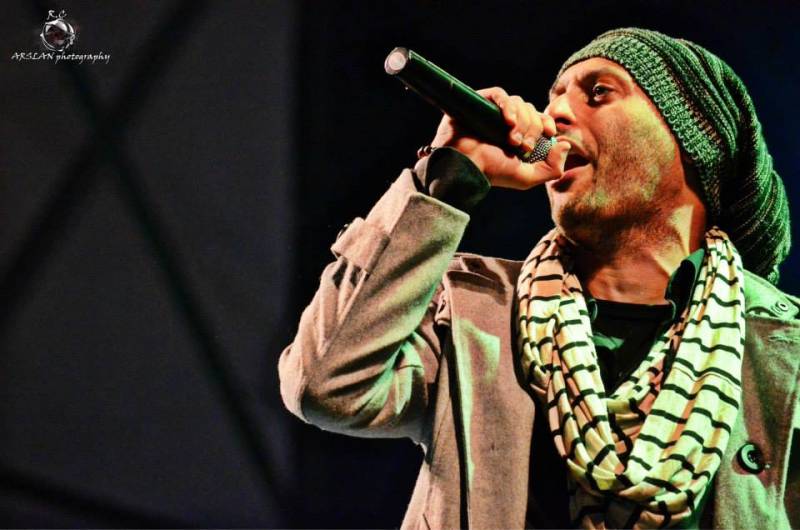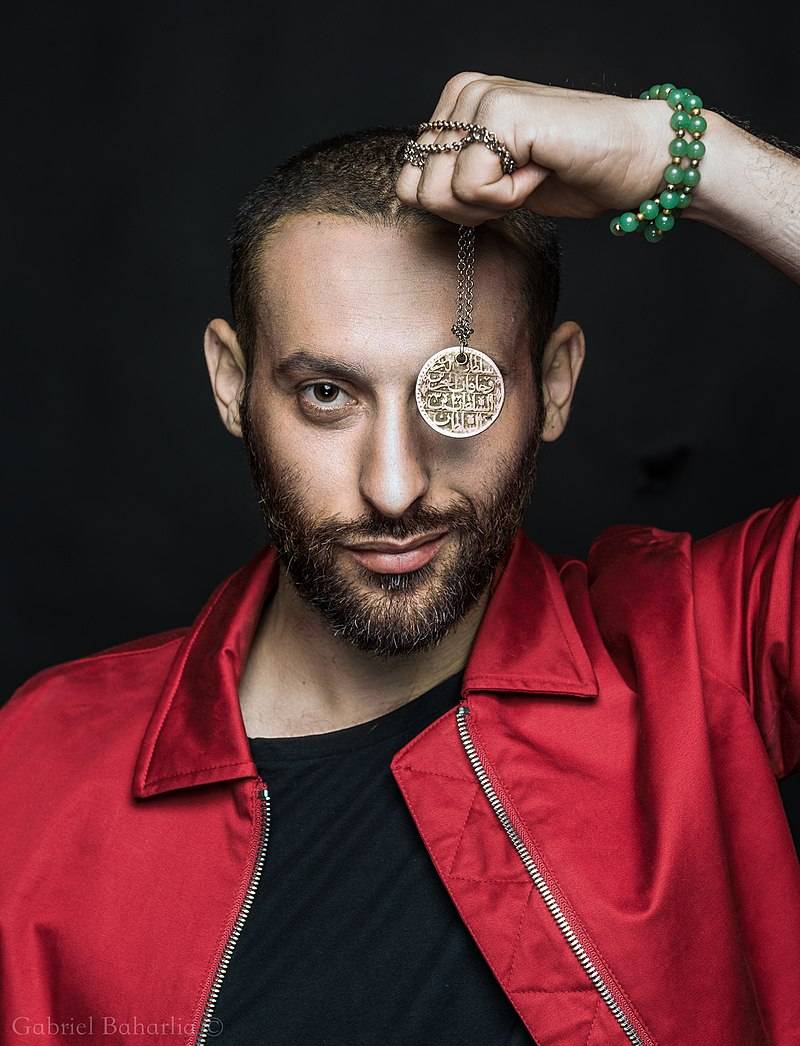On Monday evening, I attended My Life in Song, a discussion by Palestinian rapper Tamer Nafar hosted by Unit One/Allen Hall at the U of I. Nafar is from Lyd, a volatile city in Israel. Though his passport marks him Israeli, Nafar is Arab, and identifies as a Palestinian living in Israel. The history and politics of Israel and Palestine far exceed the scope of a music article, but it’s important to mention because context matters when you’re talking about art — artists, as all of us, are influenced by their environments. Nafar’s songs are necessarily politicized, because in them he speaks about his lived experience from his own cultural perspective, and it’s a tense and often contested point of view. But it’s not the only lens through which to view his work, and tonight, the theme that ran through most of the open discussion wasn’t politics — it was language.
Though Nafar is working on projects in the English language now, most of his existing music is in either Hebrew or Arabic, which means the majority of Americans from the United States can’t understand the lyrics without the aid of translation. What you can understand though is the emotion, the rhythms, the cadence that weaves through hip hop regardless of spoken language. Music, to Nafar, is a universal language. When asked how his Western-influenced hip hop was received in Palestine, he chuckled and noted “Last time I checked, hip hop was from Africa,” a nod to the fact that he first connected to hip hop because it was made by minorities communicating with other minorities, and the struggles in the stories mirror or parallel each other, regardless of geography.

Photo from Facebook
When asked about his influences, Nafar began listing hip hop artists familiar to my ear: Biggie Smalls for his storytelling, Eminem for his precision in his syllabic rhythm, Bone Thugs-N-Harmony whose songs helped Nafar identify which letters and sounds you can change the speed of to alter the sound or rhythm of a line. Tupac resonates especially deeply for Nafar, who saw his own experiences reflected in the visuals from the music video for Holla if You Hear Me. He mentioned artists recording today too: Lupe Fiasco, Kanye West, Kendrick Lamar. Nafar noted J. Cole’s line “I got a dollar and a dream, just a dollar and a dream” as inspiring his own lyric “got a shekel, a dream, and a dictionary” (shekel being the currency of Israel). He explained further, recounting his time spent searching an Arabic to English dictionary to translate Tupac and Nas lyrics. Grinning, he expressed the difficulty of translating some of the artist’s… choicer words, but these were what he especially loved — the slang, those words that were undefined by the dictionary, but translated through the shared experience of being a minority.
Nafar spoke enthusiastically about the poetry of hip hop. He rejected the notion that hip hop is valuable because it tells some truth, and instead spoke with obvious passion about the artistry of it — the metaphor, the meter, the language. He pointed the audience to a TEDx talk titled “Hip Hop & Shakespeare?”. In the first few minutes, the presenter challenges viewers to determine if a quote he recites comes from a Shakespeare play or sonnet, or if it’s a hip hop lyric. I was an English major in undergrad, and have a degree in Library Science — I did not get all of these right. Or even most of them.
Language plays a pivotal role of one of Nafar’s most recent songs. His Hip Hop group DAM released the video Jasadik Hom — Your Body Of Theirs ( جسدكهم) on March 8th for International Women’s Day. The video features Maysa Daw rawly confronting the struggle women (and particularly minority Arab women) face in claiming ownership and control of their bodies, and was inspired in part by the language in Ta-Nehisi Coates’s book Between the World and Me. The lyrics of this song use parts of grammar to attempt to make sense of a fraught issue:
“How many pronouns does my body have/There’s I and there’s you, there’s us and there’s them/Them against us and you against I, all against I and I against all.”
While grammar is by no means the central point of this staunchly feminist piece, using it to help make meaning of the broader content underscores just how fundamental language is to Nafar’s work — it is the medium, it is the vehicle, it is the framework.
If language is the means, what is the end? What does Nafar hope to achieve with his work? Nothing that you wouldn’t expect from any artist: to create, to communicate, to document, to express. Nafar straddles many borders: he is sometimes too Arab for Israelis, too Israeli for Palestinians. He raps in the languages of both places, Hebrew and Arabic, and now English. He performed the song Ana Mish Politi (I’m Not Political) in Haifa, to a crowd that was part supporter, part protester. He is a writer, a performer, an activist, and a father. For a man who says has always hated borders, Nafar has had a lifetime of navigating them.
When Monday night’s discussion opened up for questions from the audience, the first one asked was something I think we were all curious about: “What does it mean for you to be a Palestinian artist?” Nafar responded, “I chose to be an artist, I didn’t choose to be Palestinian.” He said he sees himself as an artist first, and spoke about how it can be difficult to be an artist from such a turbulent area because he wants to be valued for his skill as an artist, not his proximity to turmoil. But, said Nafar, even if he was born somewhere else, he hopes he’d be an artist fighting for Palestinian rights: “It’s a humanity thing, not a geography thing.” And though his art is necessarily shaped by his experience, I’m not sure another sentiment sums up his work more perfectly: through that nebulous magic of universal language, Tamer Nafar’s music really is a humanity thing, not a geography thing.








